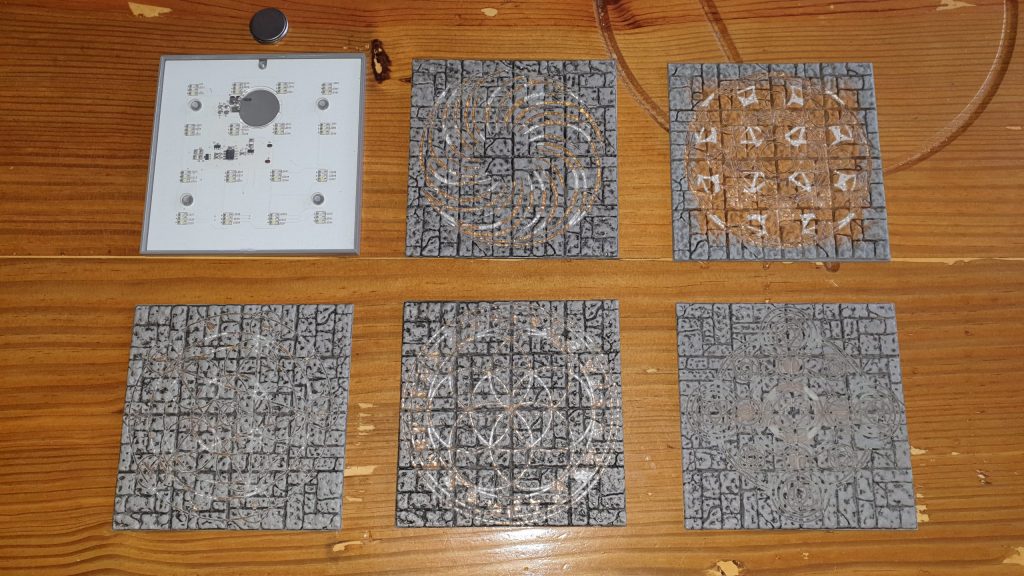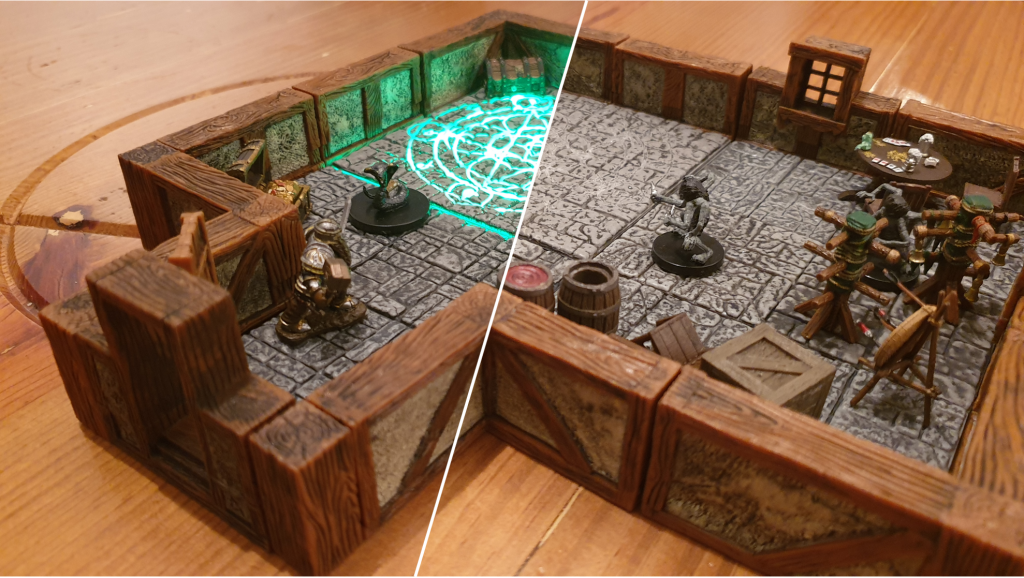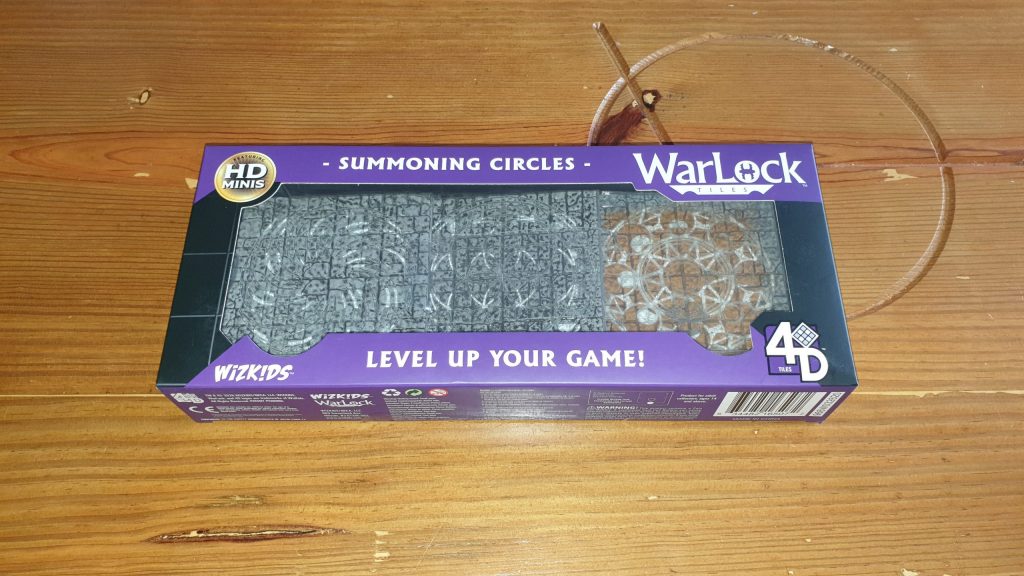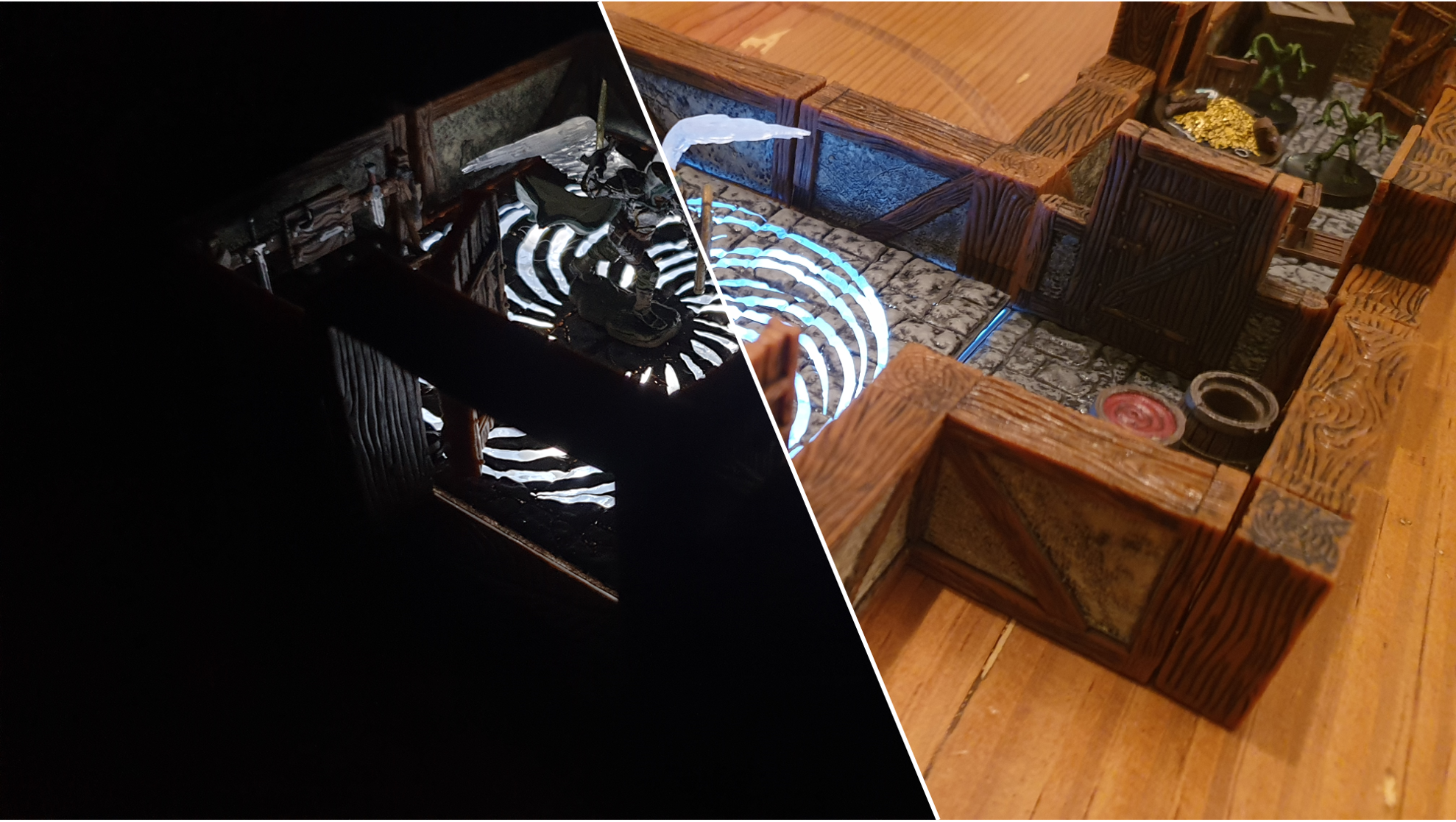Continuing our dive into the WarLock Tiles range from WizKids, today we are looking at the Summoning Circles set. This set offers gamers five pre-painted summoning circles, of different designs, coming with an LED base they offer gamers the chance to bring a spot of glow to their D&D or Pathfinder setups. The base fits into existing WarLock Tiles, though could perceivably be used with other setups. However, is this something that you need in your WarLock collection? Let’s find out!
Included in the box are 5 summoning circle toppers: an arcane circle, a druid circle, a demonic circle, a holy circle and a whirling circle. Each circle topper is a few millimeters thick, using the stone floor tile style, from the standard WarLock Tiles, with the pattern being clear plastic. These toppers are therefore interchangeable and sit, one at a time, on top of the included LED base. The base and the toppers measure 4” by 4”, so sit alongside two of the current floor tiles – fitting into a grid of tiles neatly.
The LED base is powered by a flat button battery, which comes included in the box. You will need a small screwdriver, about the size used for screws in glasses, to get into the LED base to install the battery. Such a screwdriver is not included in the set, so be aware of this requirement prior to purchasing – else your circles won’t be glowing any time soon. Being screwed in does mean it is not going to pop open, though some kind of click in and out mechanism would have made the battery installation a simpler, tool free, task.

Once the battery is in then using the LED base is a simple process, cycling through 3 “on” styles and 3 colours via a simple press to the center of the base unit. The unit is sensitive enough that this press can be made with a summoning circle topper on top, with a noticeable click noise when it has been pressed. The styles are always on, with two types of pulsing on and off – with the three styles the same across the three colours: green, red and white.
The reverse of each circle topper is covered with a grid of little white squares. These sit directly above the 16 LEDs, stopping the light sources being insanely obvious through the pattern. By reflecting some of the light back down, which is in turn reflected back up from the base, it diffuses the light, giving a more evenly spread glow. This means that it doesn’t look like the light is simply coming from the 16 LEDs in specific points of the base.
The summoning circle toppers sit flat on top of the LED base unit, with nothing securing them in place – which would have helped the topper stay neatly aligned. This method allows the toppers to be switched within seconds, though when a room is set up chances are the exact summoning circle being used won’t need to be changed. The top of the base unit and the bottom of the toppers are both smooth plastic, so there is little grip between the two. This can see the tops nudged by miniatures being moved on them. A spot of tack or tape can fix this but it shows an oversight with the products design. While the base unit itself is a millimeter shorter than normal WarLock Tiles, when adding the toppers on they sit equal to the tiles around it.

A big selling point of the WarLock Tiles system is the ability to fully clip a location together. Much like the top of the base unit the sides are smooth, with no holes/gaps for clips. While having the option would have been nice, it does almost encourage DMs not to have them set up, alerting players to their presence. Instead, you can have pre-built an area of normal stone flooring. When the time comes the dungeon master can then remove a 4” by 4” section to drop the LED base into – when the event occurs. This gives another usage option from simply tapping them on and off.
The five summoning circles are all different designs, with one even having orange colouring on the stone floor around the circle itself. With the way they are separate from the base unit, it allows them to all be used with any of the LED colours, so DMs can choose their favourite, what fits the scene best or dependant on what is being summoned. On a couple of the tiles the light seeps through some of the cracks in the stone flooring, giving extra sparkle to the summoning magic that is taking place. Unfortunately, and it only minutely detracts from the overall look, some of the light does spill out from the edges of the toppers. This is especially the case when they get knocked or nudged – adding more weight to using a bit of tack to keep them in place.

Whilst what is included is an interesting variety of designs, they are all on stone flooring. Given the ability to flip the WarLock Tile floor pieces from stone to wooden boards it is a bit of an odd choice, to not to even include one wooden board topper design. Be it for when a party stumbles across a summoning in the back of a dodgy tavern, a haunted house or a chapel. Players can obviously work around this by using stone floor sections, though even including one wooden board design would have helped negate this.
Not every D&D campaign will have things being summoned in, well at least until players pick up the Summoning Circles set. Suddenly, DMs will find side quests for adventurers specifically so that the team can stumble across more of them. After the opening doors of the base sets and the expansion, the Summoning Circles set is currently the only other WarLock product that can breath a wave of movement, a non-staticness, into the environments. There are a few oversights with the product. With a product like this there shouldn’t be things to work around, be that the lack of circle designs on wooden boards or the way the toppers slide without tack. Nevertheless, these issues do not hold the product back from being that wow factor they set out to be.
(Editor’s Note: The WarLock Tiles Summoning Circles set was provided to us by Asmodee for the review. The set is currently available from local board game stores, some of which are reopening! Find your local store here.)

